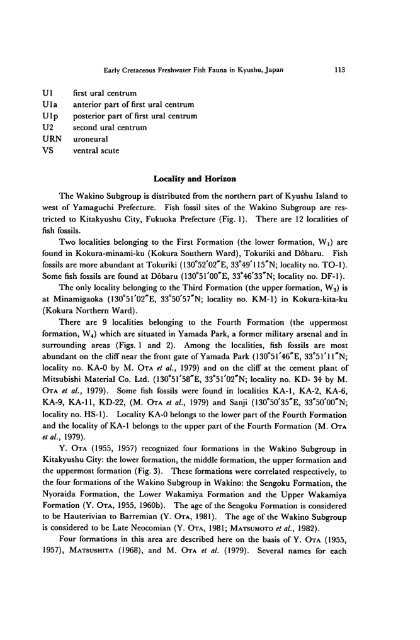Early Cretaceous Freshwater Fish Fauna in Kyushu, Japan
Early Cretaceous Freshwater Fish Fauna in Kyushu, Japan
Early Cretaceous Freshwater Fish Fauna in Kyushu, Japan
Create successful ePaper yourself
Turn your PDF publications into a flip-book with our unique Google optimized e-Paper software.
<strong>Early</strong> <strong>Cretaceous</strong> <strong>Freshwater</strong> <strong>Fish</strong> <strong>Fauna</strong> <strong>in</strong> <strong>Kyushu</strong>, <strong>Japan</strong> 113<br />
Ul<br />
U1 a<br />
U1p<br />
U2<br />
URN<br />
VS<br />
first ural centrum<br />
anterior part of first ural centrum<br />
posterior part of first ural centrum<br />
second ural centrum<br />
uroneural<br />
ventral scute<br />
Locality and Horizon<br />
The Wak<strong>in</strong>o Subgroup is distributed from the northern part of <strong>Kyushu</strong> Island to<br />
west of Yamaguchi Prefecture. <strong>Fish</strong> fossil sites of the Wak<strong>in</strong>o Subgroup are res<br />
tricted to Kitakyushu City, Fukuoka Prefecture (Fig. 1). There are 12 localities of<br />
fish fossils.<br />
Two localities belong<strong>in</strong>g to the First Formation (the lower formation, W|) are<br />
found <strong>in</strong> Kokura-m<strong>in</strong>ami-ku (Kokura Southern Ward), Tokuriki and Dobaru. <strong>Fish</strong><br />
fossils are more abundant at Tokuriki (130°52'02*'E, 33°49'l15"N; localityno. TO-1).<br />
Some fish fossils are found at Dobaru (130°5l'00"E, 33°46'33"N; locality no. DF-1).<br />
The only locality belong<strong>in</strong>g to the Third Formation (the upper formation, W3) is<br />
at M<strong>in</strong>amigaoka (130°5l'02"E, 33°50'57*N; locality no. KM-1) <strong>in</strong> Kokura-kita-ku<br />
(Kokura Northern Ward).<br />
There are 9 localities belong<strong>in</strong>g to the Fourth Formation (the uppermost<br />
formation, W4) which are situated <strong>in</strong> Yamada Park, a former military arsenal and <strong>in</strong><br />
surround<strong>in</strong>g areas (Figs. 1 and 2). Among the localities, fish fossils are most<br />
abundant on the cliffnear the front gate of Yamada Park (130°5r46*E, 33G5ril"N;<br />
locality no. KA-0 by M. Ota et al., 1979) and on the cliff at the cement plant of<br />
Mitsubishi Material Co. Ltd. (130°5r58"E, 33°5f02'rN; locality no. KD- 34 by M.<br />
Ota et al., 1979). Some fish fossils were found <strong>in</strong> localities KA-1, KA-2, KA-6,<br />
KA-9, KA-11, KD-22, (M. Ota et al., 1979) and Sanji (130°50'35*E, 33°50'00*N;<br />
locality no. HS-1). Locality KA-0 belongs to the lower part of the Fourth Formation<br />
and the locality of KA-1 belongs to the upper part of the Fourth Formation (M. Ota<br />
et al., 1979).<br />
Y. Ota (1955, 1957) recognized four formations <strong>in</strong> the Wak<strong>in</strong>o Subgroup <strong>in</strong><br />
Kitakyushu City: the lower formation, the middle formation, the upper formation and<br />
the uppermost formation (Fig. 3). These formations were correlated respectively, to<br />
the four formations of the Wak<strong>in</strong>o Subgroup <strong>in</strong> Wak<strong>in</strong>o: the Sengoku Formation, the<br />
Nyoraida Formation, the Lower Wakamiya Formation and the Upper Wakamiya<br />
Formation (Y. Ota, 1955, 1960b). The age of the Sengoku Formation is considered<br />
to be Hauterivian to Barremian (Y. Ota, 1981). The age of the Wak<strong>in</strong>o Subgroup<br />
is considered to be Late Neocomian (Y. Ota, 1981; Matsumoto et al., 1982).<br />
Four formations <strong>in</strong> this area are described here on the basis of Y. Ota (1955,<br />
1957), Matsushita (1968), and M. Ota el al. (1979). Several names for each

















